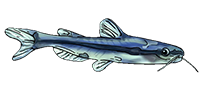Bas Pels wrote:Phoxinus, could you PLease, Please tell exactly EVERYTHING there is to know about their tank?
Of course. The dimensions of the 420-liter aquarium are 130cm x 61cm (height) x 53cm (width). There are two filters: Eheim 2228 canister filter (1050l/h) and a mat filter with Eheim Aquaball pump (600l/h) in the tank. The water is well oxygenated because the both filter pump outputs are located a couple of sentimeters above the surface of the water. The temperature of the water is 27-28 Celcius. I have no heater in the aquarium and the temperature falls a degree or two at night. I occasionally rise the temperature to 29 Celcius to induce Hoplos to spawn. There is a big cave in the middle of the tank built with pieces of magrove tree (about 30x20x20(height) cm in the inside measure (in the picture). There are also a coconut cave and a clay cave where the female Raphael catfish lives. The bottom material is whitish quarz sand. There are no plants rooted in the sand but there are free floating plants near the surface of the water (Ceratophyllum demersum, Elodea, Ceratopteris and java moss). A plastic lid is floating on the surface for Hoplos where they can build their bubble nests. One 30W fluorescent lamp is on twelve hours a day.
I change 50-60% of the water weekly to tap water. The pH in the tank water is about 6 and after the water change it rises to about 7. The water is soft. When I kept ketapang tree leaves and oak leaves in the aquarium for the Hoplos spawning, the pH drop down to about 5,5. I feed the fishes heavily one or two times a day with soaked flake food, garden peas and shrimp. Plus they get blood worms or white worms two or three times a week. I give the white worms straight from the container and the water gets quite cloudy because of the soil during the feeding.
The male Raphael catfish lives in the big mangrove cave structure. When the female swims into the cave, the male starts to chase and even bite it. I believe the spawning occurred in this cave during the night. Another possibility could be spawning in the vegetation. Platydoras hancockii is known to build a bubble nest (says in Catelog) so I wouldn’t be surprised if P. armatulus could spawn near the surface as well.












